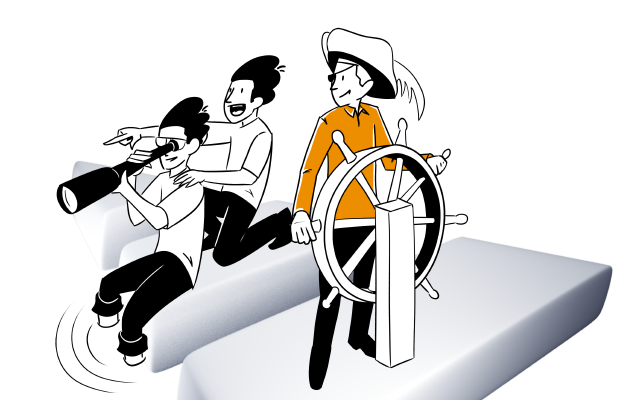Technological innovations are changing the landscape of the banking industry and creating more opportunities to tap into. Banks and the financial sector strive to provide a compelling customer journey.
With so much data at hand, you’d think it would be an easy task. As it turns out, however, technological advancements like web analytics are not being used to their full potential.
According to a survey conducted by Marketforce Business Media and Earnix: among banking professionals working in operations, customer experience insights, IT, sales and marketing, 76% of respondents confirm that banks need more analytical capability to get the most out of new data sources. And 65% of them believe banks aren’t taking full advantage of the transactional and account data they already have.
When it comes to use cases for applying analytics, banking really isn’t much different from retail or any other business. It’s all about acquisition, reducing churn, up-selling and cross-selling, and finally winning back customers.
That’s why it’s crucial to have a good strategy in place and identify opportunities to employ it.
Today, we’ll show you how to use a web analytics and CDP duo to better track your customers’ journey and build up single customer view profiles. We’ve employed a classic marketing funnel to illustrate the possible scenarios.
Bear in mind, however, that the funnel itself is a flexible concept that marketers and analyst tailor to their own goals, so each specialist might build it differently.
To get a fuller overview of funnels, check out our other posts:
Top of the funnel – tracking the first steps of the customer journey
Let’s say a new visitor comes to your demo.piwik.pro/bank site and moves around a bit. At first they just scroll and switch between subpages like services and loan calculator, then they find a mortgage calculator as well.
Now if you dive into a CDP, you’ll find all these actions reflected in a visitor’s profile. Here’s the customer we’ve been tracking:

First off, you can now recognize individual users, as they receive a unique ID. Alongside this you gather basic data on your visitor, including:
- Geolocation: country & city
- Technology: browser, device type (desktop, mobile, tablet or smart TV), operating system and version
- Time: date and time of the first visit recorded, overall time spent on each page
Free Comparison of 7 Enterprise-Ready Customer Data Platforms
Get to know over 50 key differences to determine which platform fits your business needs best: Tealium, BlueVenn, Exponea, mapp, Segment, mParticle or Piwik PRO
Every user action provides data that enriches the single customer view (SCV). This includes scrolling, clicking, visiting any subpages and any other action a user might take. The customer data platform lets you not only build granular user profiles but also constantly expand them.
If you want to get more familiar with the concept of SCV, check out our post:
Single Customer View (SCV): What is it and How Does it Work?
For instance, here you’ve got a visitor’s log that shows you how the user interacts with the site.

Measuring users’ engagement with your content is not only about which sites they view. A good practice is to track how deep into the site users scroll while browsing an individual page. Such data is especially valuable when you want to focus on content consumption metrics.
As the user clicks further through the site you enrich their profile with more granular behavioral data. They go even deeper into your site and are shown the following slider:

The user can switch the slides by going back and forth, then click the call-to-action button, and all their behavioral data will be automatically sent to a CDP that updates their profile (like in the screen below):

But that’s not all. When visitors browse your website, they leave more traces of their preferences and behavior. For instance, you can use different forms to further enrich your user profiles:
- Mortgage and loan calculator
- Request a meeting with advisors
- Account, card and loan applications
- Getting a quote
- Expense tracking form
And now, as your visitors move away from the slider, they navigate to the mortgage calculator and fill in all the required fields.

After they hit the calculate button, all the data goes straight to the single customer view profile. You can find it under the Attributes tab:

In this way you learn the duration and total amount of loan they’re interested in, the interest rate that suits them and down payment they’re willing to make.
This information will be highly valuable when the people from your sales team approach this client, because they will know exactly what type of offer to prepare.
Last but not least, submitting the calculator form is one of the micro conversions in the marketing funnel. These are exactly what you need to estimate the quality of your visitor traffic.
Such micro conversions mean that your users aren’t just random visitors, but are in fact really interested in your service.
At this stage it’s also likely that the user will fill out the contact form, and that would be a milestone in the customer journey as it moves the user further down the funnel.
However, when it comes to milestones on the journey there’s no single definition. Depending on the business you’re in and the goals you set, a milestone could be, for instance, acquiring around 20 attributes of the user profile, or the user signing up for a trial.
Middle of the funnel – turning an anonymous user into a prospect
Once the visitor submits their form, they’re not anonymous anymore. You can recognize them now by email address instead of just random numbers in their ID. Let’s say the prospect completes an application form like this:

All information from the form will flow to your CDP. Now, with the the prospect’s email address you can merge this data with information you already have.
So, let’s have a look at your prospect’s profile now:

Finally, you have a concrete profile of your prospect. However, judging by the profile, you can gather that not all form fields were completed, because otherwise more data would be visible. Maybe the user found it too complicated, or maybe the form demanded too much information. That’s a valuable hint for you when redesigning the form: simplify it to make it more user friendly.
Still, as your prospect continues their journey, they might decide to come back to your site after a short time, and you’ll be able to easily recognize them.
And when they hit the Talk with an agent button, you’ll be ready to deliver them a tailored offer. You already know what they were looking for and what products sparked their interest because you have a full record of their behavior at your site plus data from the submitted forms.

If you’re curious about how to track anonymous users, have a look at our post:
Anonymous Tracking: How to Do Useful Analytics Without Personal Data
Bottom of the funnel – getting a more detailed profile
When your prospect completes another form, this automatically enriches and updates the profile. Thanks to data from your CDP, your sales team can prepare a customized offer. After all, they know exactly what the prospect was looking for, what pages were visited, and which pages were the most engaging.
Every single step your prospect takes and every piece of information they provide during the meeting with the advisor will flow to the CDP and further develop their profile. All that will be reflected in their profile, precisely under Custom Attributes.
Free comparison of leading enterprise-ready web analytics platforms
Get to know over 50 key differences to determine which platform fits your business needs best: Tealium, BlueVenn, Exponea, mapp, Segment, mParticle or Piwik PRO
You’ll get not only precise contact information but also data on the purpose and value of the loan, the prospect’s income, employment and any additional information your bank can use.
Remember that when it comes to granularity of data, a lot depends on your form, how complex it is and how you configure your software. For instance, you can ask about
- why they’re applying for a loan
- what value of loan they want
- what they earn
- what line of work they’re in
All this information will then be visible under custom attributes.
Here’s the more detailed profile view you get with custom attributes:

With the data you’ve collected and merged in your customer data platform, you’re able to prepare offers more relevant to your prospects and convince them to become paying customers.
That demonstrates how having a single customer view is essential to moving users through the customer journey to the retention stage. And the usefulness of the CDP doesn’t end here, as we’re about to show you.
Retention stage – diving deeper and tracking secure member areas

For many banks, when they acquire a customer the journey comes to an end. That’s a big mistake. Retaining clients can be demanding and complex, but it’s worth the investment so as not to lose clients faster than you can acquire them.
What’s more, because of security and privacy restrictions some analytics software will have to stop here and won’t measure users’ behavior in post-login areas. That’s a significant drawback. But it doesn’t mean you have to accept these limitations.
Fortunately, there are vendors who let you track customers in secure member areas while complying with all legacy regulations. For instance, Piwik PRO leverages its on-premises infrastructure so you can track users’ actions in post-login areas. This allows you to have a complete picture of the whole customer journey without losing any touchpoints or important data.
But that’s not all. With a solution like this, you can employ the data in a safe and sound ecosystem of other marketing tools like Tag Manager, CDP, and GDPR Consent Manager.
Whether it’s behavior before or after logging in, the data just keeps on building up the single customer view profile in the CDP. Then you can promote your product to the right audience, lift engagement, and take advantage of retargeting, cross-selling and up-selling opportunities with even better precision.
If you want to get more details on tracking customer behavior in post-login areas, have a look at our post:
How to Capture the Whole Customer Journey When Dealing With Secure Member Areas
Let’s get back to our user, who we successfully turned into a buying customer. You have all the data on their previous actions and you can see how their needs evolve over time.
If they log in and want to apply for a time deposit, but first spend some time moving around your website, you can learn about all their behavior. Just take a look at their profile:

Here you have a list of all the events and touchpoints relating to your customer’s post-login activity:
- the moment when the customer logged in to their account
- the customer’s interactions with the banner slider – switching from slide 1 to slide 2 to slide 3
- the moment the customer clicked the slider CTA
- the customer being redirected to the application form
Here’s the simple deposit form:

The information the customer drops on the form will go straight to their single customer view profile, enriching it even further. Then you’ll be able to offer customized service that matches their true needs and preferences.
Final thoughts
Capturing the full customer journey and building a 360-degree customer view are complex issues. But you absolutely need to account for them in your marketing strategy.
For the banking and financial sector, regulations, erratic customer loyalties and adoption of new technologies seem to be the toughest challenges here. So you’ve got to stay alert and spot the smallest edges, which lead to the biggest gains.
Free Comparison of 7 Enterprise-Ready Customer Data Platforms
Get to know over 50 key differences to determine which platform fits your business needs best: Tealium, BlueVenn, Exponea, mapp, Segment, mParticle or Piwik PRO
The web analytics and customer data platform duet is perfect for this job, as this combo allows you to spot and fix a myriad of small issues that add up.
Naturally, analytics itself is not enough – you need to know where you can employ it. Hopefully, we’ve managed with today’s post to show you how analytics enables you to follow your customers along their journey, smoothing their path and removing any obstacles.
We know there’s a lot more to be said about this, so if you have any questions just …
If you want to learn more about customer data platforms, here you can find materials that describe it in more detail:













